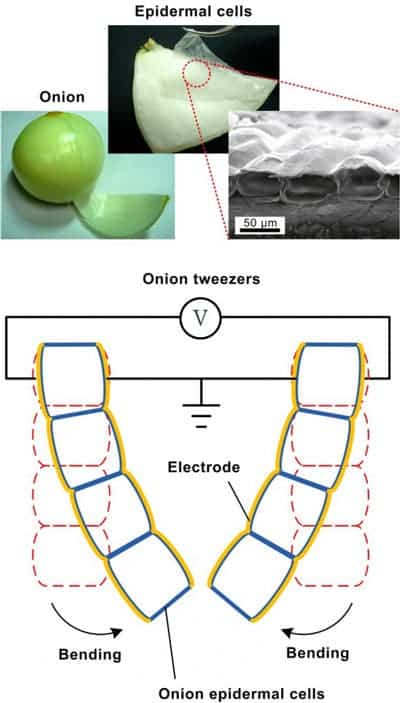When it comes to artificial muscles, researchers at from National Taiwan University really know their onions. The team applied an uncanny design in which they layered gold atop the treated skin of onions. Once an electrical current was discharged, the “onion muscle” contracted and bent, just like the real thing. There’s a whole slew of possible applications for artificial muscles, from so-called “soft robotics” (flesh-like droids), to of course helping injured humans.

Most artificial muscle models presented thus far were made from polymers, and unfortunately fail when it comes to replicating real muscle quality like staying soft and bendable even when contracting.
“There are artificial muscles developed using elastomers, shape memory alloys, piezoelectric composites, ion-conductive polymers and carbon nanotubes,” says Wen-Pin Shih of National Taiwan University in Taipei for ZME Science. “The driving mechanisms and functions are very diverse.”
Onion is not only a cheaper natural substitute to polymers, it’s actually far better for the task at hand. The team only used the epidermis of the onion, however – its skin. This thin film is both stretchy and responsive to electricity. The skin was then freeze-dried to remove any excess water, then bathed in dilute sulfuric acid to increase elasticity by removing the hemicellulose, a protein that makes the cell walls rigid. Gold was layered on both sides for increased electrical conductivity. Finally, when a current was transferred through the onion, it bent and stretched much like a muscle. What a tear jerker!
“We intentionally made the top and bottom electrodes a different thickness so that the cell stiffness becomes asymmetric from top to bottom,” said Shih.
Indeed, this way when a low voltage (0 to 50 volts) was applied the onion muscle expanded and flexed downwards, while a high voltage (50 to 1000 volts) caused the cells to contract and flex upwards. By carefully controlling the voltage, the team was able to grab a small cotton ball using the onion muscle.

The high voltage, however, makes it impracticable for use in mobile applications like tiny bots, which typically use small batteries. “We will have to understand the configuration and mechanical properties of the cell walls better to overcome this challenge,” Shih notes.
Also, another drawback of using vegetables in high tech devices is durability. Decay and water infiltration are two main issues that need to be highlighted, with this in mind. Shih already has a plan for this: applying a very thin fluoride layer to keep water out, while also retaining the bending/contracting ability. The onion muscles was reported in a paper published in Applied Physics Letters.
Artificial muscle is quite the thing in research today. A while ago, ZME Science reported how University of Texas at Dallas researchers found a way to manufacture artificial muscle that is up to 100 times stronger than the flimsy tissue that makes up the human biceps. The material is made out of nylon fibers – the stuff fishnets are made of – that are tensed almost to the upper limit and thermal processed to retain a high energy density.


